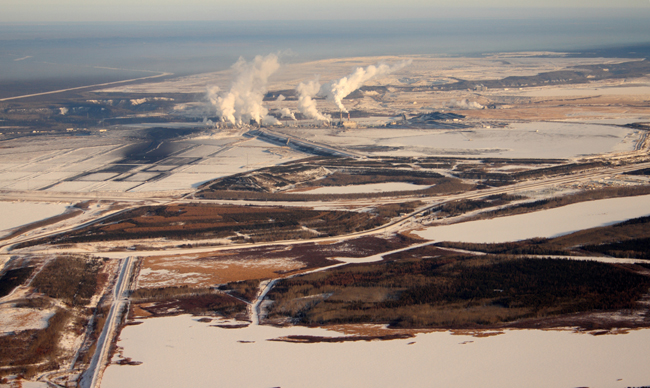Are Canada's oil sands to blame for rising atmospheric CO2?

In a recent New York Times opinion piece, NASA climate scientist James Hansen again puts forward his very compelling argument for strong action on limiting global CO2 emissions. Some observers have challenged his thinking, but the warnings he has given over the last thirty years have proven to be pretty much on the mark as observations show that the world is warming.
In the most recent piece, Hansen links the production of synthetic crude from oil sands bitumen in Alberta as a game changer for the climate. He states;
That is why I was so troubled to read a recent interview with President Obama in Rolling Stone in which he said that Canada would exploit the oil in its vast tar sands reserves “regardless of what we do.” If Canada proceeds, and we do nothing, it will be game over for the climate… … . The concentration of carbon dioxide in the atmosphere has risen from 280 parts per million to 393 p.p.m. over the last 150 years. The tar sands contain enough carbon — 240 gigatons — to add 120 p.p.m.
There is no doubt that the oil sands bitumen reserves in Canada are very significant. In a recent report the Alberta Energy Resources Conservation Board (ERCB) estimates that provable reserves stand at some 170 billion bbls, with a potential total reserve of some 1.7 trillion bbls. The first figure represents the current estimate of recoverable oil on the basis of existing technology, whereas the latter is indicative of the total amount of oil in the region, recoverable or not. The second figure is the one that equates to 240 gigatons of carbon quoted by James Hansen.
But actual production of oil from the region gives rise to a completely different set of figures. Production of oil sands bitumen started in the late 1960s and by 2010 had reached some 1.6 million bbls per day (ERCB figures). ERCB estimates production at about 3.6 mbbl/day by 2020. Assuming an increasing trajectory which sees production doubling again by 2050 (to 7 million bbbls/day), total cumulative production over 80 years would be 74 billion bbls, which equates to some 35 billion tonnes of CO2 emitted through the production and use of the oil. This equates to an increase in atmospheric CO2 of about 2 ppm (by contrast, Saudi production over the same period could contribute about 6 ppm). If production continued through to 2100 and reached 10 million bbls/day, cumulative production would exceed current proven reserves (so assuming technology improvements) and would equate to an increase in atmospheric CO2 of about 7 ppm over 130 years of production. The resource may be vast, but production is limited by the rate at which new projects come on stream. Given a scenario of complete inaction on climate change over the very long term, it may well be that oil sands might eventually contribute some 100 ppm to atmospheric CO2 levels, but that could take 1000 years. Current trends would likely have us hitting a climate induced “brick wall” long before that.
The point here is not to argue that this is all OK or that James Hansen is wrong, but to illustrate that the issue of CO2 emissions and the resulting climate impact cannot be linked to any individual fossil fuel extraction. Each and every major reserve on the planet can clearly only contribute a few ppm at most over the coming 50 to 100 years, but so goes the tragedy of the commons. This of course highlights the critical need for collective action.
The point that Hansen is really making is that oil sands is illustrative of an ongoing global trend to extract or mine increasingly challenging reserves of oil, gas and coal and bring them to market. Global energy markets are driving this behaviour and will probably continue to do so as population increases and economies develop. Put simply, energy is in demand and the market will respond.
Given the recent change in estimates for global natural gas supply, there is now evidence that the availability of fossil fuels may not be self limiting, at least for a century or so (and possibly much longer as extraction technology improves). This argues strongly for the introduction of carbon pricing, which Hansen also calls for in his opinion piece.
Carbon pricing is the essential precursor to technologies such as carbon capture and storage (CCS), which may be the only available route forward to allow both energy demand to be met and CO2 emissions reduced. Alberta has at least started down this route, with a C$15 price driving behaviour in oil sands operations. That price, in combination with a technology incentive package, should see CCS activity emerge as part of future oil sands development.
You can return to the main Market News page, or press the Back button on your browser.

